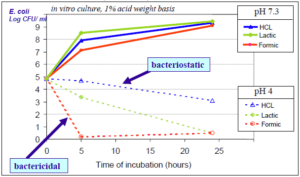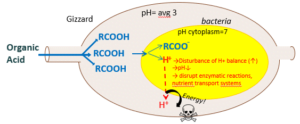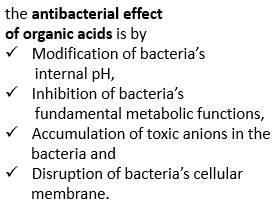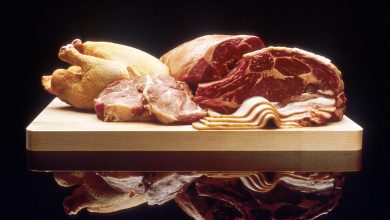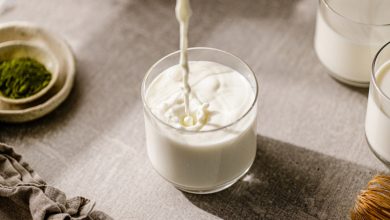Improved performance through improved water quality
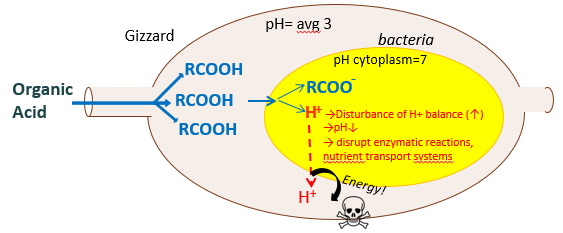
Dr. Koushik De
Regional Technical Manager-SCA
NOVUS Animal Nutrition
The gradual removal of all antibiotic growth promoters from animal feed has focused attention on other strategies for ensuring efficient production and bird health. Inorder to reach this objective, producers have combined improved systems to reduce microbial contamination in feed with changes in diet structure and composition to optimize the gut microflora. The interest in the use of organic acids (OAs) in poultry is based on their potential to provide a mechanism for sanitization of the feed or water and also the possibility of modifying the gut microflora. Single acids and acid blends have been used in poultry diets to improve feed efficiency and also to reduce Salmonella contamination in feed and this approach has been extended to treatment of drinking water. Using OA in water is an efficient way to treat or prevent enteritis with a lot of flexibility in dosage and timing of application. Acid applications in the drinking water generally have their antimicrobial activity by decreased pH to prevent bacterial growth with a “mouthwash effect”. Selection of a single acid or an acid blend, however, requires an understanding of the mode of action of the product in order to target a particular production situation
Organic Acids and its importance:
Organic acid is defined as a carbon containing molecule with at least one carboxyl group with the general structure (RCOOH). Many compounds are therefore organic acids, however only a small number is of interest for their biocide and growth promotion properties. Organic acids are one of the most feasible candidates for non therapeutic antibiotic replacement in poultry production. Like antibiotics, organic acids have a specific antimicrobial activity; that is particularly effective against acid-intolerant species such as C. perfringens, Salmonella, Campylobacter and Listeria. The degree of antimicrobial effect varies from one acid to another and is dependent on the concentration and pH.
Difference between organic acids and inorganic acids:
As already stated organic acids are characterized by the presence of a carboxylic acid group (COOH). Inorganic acids such as hydrochloric acid (HCl) do not contain this functional group. Inorganic acids are good at reducing pH, but unlike organic acids are not particularly good antimicrobials.
Organic acids used in animal nutrition:
The main organic acids used in animal nutrition are formic, propionic, butyric, lactic, acetic, fumaric, citric, sorbic, benzoic, and HMTBa. They are used “as is” as acids or as salts of ammonium, calcium or sodium, potassium. The mineral acids like phosphoric acid and sulfuric acid can also be used to create blends. All these acids have specific individual properties. Their association in blends makes sense to take advantage of additive or potential synergistic effects. (chart1)
Chart 1: Main organic acids used in animal nutrition, their state – Liquid or Powder –, Molecular Weight and pKa. (Novus)
| Acid |
State |
Formula | MW | pKa |
| Formic | L | H COOH | 46 | 3.75 |
| Acetic | L | CH3 COOH | 60 | 4.76 |
| Propionic | L | CH3 CH2 COOH | 74 | 4.88 |
| Butyric | L | CH3 CH2CH2 COOH | 88 | 4.82 |
| Lactic | L | CH3 CH(OH) COOH | 90 | 3.83 |
| Sorbic | P | CH3 CH:CH CH:CH COOH | 112 | 4.76 |
| Fumaric | P | COOH CH:CH COOH | 116 | 3.02 |
| Malic | P | COOH CH2 CH(OH)COOH | 134 | 3.40 |
| Tartaric | P | COOH CH(OH) CH(OH) COOH | 150 | 2.93 |
| HMTBa | L | CH3S CH3 CH2 CH(OH) COOH | 150 | 3.53 |
| Citric | P | COOH CH2 C(OH)(COOH) CH2 COOH | 192 | 3.13 |
The main role of organic acids is to provide specific biocide activity against bacteria, yeast and molds. The response of certain OA controlling bacterial growth is pH dependent (chart 2). Therefore, certain OA are good candidates for control of bacterial growth in the stomach, but not good candidates for control of bacterial growth in the small intestine.
Chart 2: Certain organic acids are strong bactericides at low pH. A pH of 4 controls the bacterial growth. At this same pH the presence of lactic or formic acid demonstrates a bactericide effect. (MRP, 2000)
Mineral acids like sulfuric acid or phosphoric acids do not have the biocide properties of OA, apart from their pH effect (chart 2).
Antimicrobial mechanisms of Organic Acid:
Only a few OA have antibacterial properties and to very different degree. It is likely related to their non-dissociated form [R-COOH]. This chemical form is lipophilic and can enter the bacteria membrane more easily than the dissociated form. Once inside the cell, it can express its toxicity to the cell.
For all organic acids, the lower the pH, the more there will be active non- dissociated forms, the stronger the effect.
pKa value does not always predict OA biocide properties:
The pKa is a chemical measurement, it is the pH at which 50% of an acid is dissociated and non-dissociated in solution. It is not a predictor of biocide properties: formic (pKa: 3.7) and lactic (pKa: 3.8) have similar pKa and formic has stronger antibacterial effects. Lactic acid has a lower pKa than sorbic acid (pKa 4.7) but is less antibacterial. However, an OA with a low pKa will be much more biocide at low pH than at higher pH, as more of it will be non-dissociated. This is particularly the case for formic acid. A biocide OA with a higher pKa, like sorbic acid, is more likely to be active at higher pH. The same can be said for propionic acid (pKa 4.88). In conclusion, pKa is not good at predicting the biocide effect of an OA but predicting the pH range of effectiveness of OA with biocide properties.
Importance of Formic acid in organic acid blend:
Formic acid has a strong bactericide at low pH conditions (pKa 3.75, chart 1). This effect is likely the strongest among all OA . Formic acid is also a strong acid in terms of impact on pH and Acid Binding Capacity (ABC), the closest to mineral acid. Its low molecular weight (46) means it brings more H+ than any other organic acid on a weight basis. It is utilized in most OA blends. Formic is very volatile, pungent and corrosive, making its usage difficult. This pungency / aggressiveness is often reduced by buffering with ammonia, to the detriment of its efficiency.
Importance of Propionic acid in organic acid blend:
Propionic is the strongest antimold OA with also bactericide properties. This acid can be used alone in raw materials of feed as an effective antimold. In blends Propionic is often complemented in this usage with some formic acid for a good coverage of mold and bacteria.
Importance of HMTB acid inorganic acid blend:
HMTB acid is the only known OA with biocide properties including sulfur (Chart 1). It is mainly used in the feed industry as a methionine source. The bactericide properties of HMTBa are similar to those of formic acid and a strong synergy between the two acids exists. In enteritis, where gut cells are exposed to a high rate of toxins and free radicals, an additional methionine source as a methyl donor for the gut is also of interest for being a precursor of spermine and spermidine (gut cell growth promoter) and of glutathione and taurine (major in vivo detoxifiers and antioxidants).
Sometimes the common question arrive that Why don’t organic acids damage desirable organisms like lactobacillus spp? Organisms as lactobacillus spp., have evolved to thrive in acidic environments. The normal pH of the upper (proximal) GI tract typically ranges between 2 and 4, so organic acid will preferentially eradicate undesired pathogens over lactobacillus spp.
Correct Use of Organic acids:
In order to achieve the maximum efficacy, it is necessary to reach a pH in the drinking water of 3.0 to 3.5. But at the same time, it has to be kept in mind that the water should be drinkable to the bird. Alternatively, the pH can also be adjusted between 4.5-5.0 also. The amount of organic acid it takes to reach that level depends on your water hardness but typically ranges from 0.04% to 0.1%. Different natural contaminants in water, particularly carbonates, will buffer the acidification of organic acid blend. Consequently, it is best to measure the hardness of the water and adjust the addition rate accordingly.
With all organic acids, the lower the pH the greater the amount of acid that is present in its undissociated form. It is the undissociated form that can enter the cell wall of the target pathogens. HMTBA is one of the key acids and it has a pKa of approximately 3.5 (pKA is the pH at which half of the acid is in its undissociated form and half is dissociated).
Duration of Treatment:
For best results, nutritional organic acid can be used from placement all the way through grow out. Alternately, organic acid may be used for the first 14 days following placement and then again for the final 7 to 10 days prior to harvest. Use of organic acid early in a bird’s development helps to establish a preferred microbiota. Use of organic acid later in life serves to control harmful pathogens that may harm bird health and performance.
There is no withdrawal time associated with the use of organic acid. Unlike many drugs and antibiotics, the organic acids are readily utilized in the animal’s GI tract and actually serve as a source of nutrients.
Precautions to be taken care when handling this product:
- As with all acids, it is important to handle carefully and avoid eye or skin contact. Organic acid has a low pH (~2.5 for a 1% solution).
- It is strongly recommended that the drinking water lines be cleaned and rinsed prior to initiating organic acid Organic acid itself is not intended to clean off the biofilm layer that routinely builds up on the inside of water delivery lines. A biofilm is occurring when organic matter is introduced in water. Bacteria multiply using this organic matter as a source of energy and rapidly create a film that will block pipes and nipples. At a low dose (like 0.2, 0.3 g/L), OA do bring organic matter without any antibacterial effect if pH is not low enough. When this occurs, it is recommend increasing the dose to get a pH around 4 or less. (Increasing the dose will also increase the effect in the animal.) Using an OA in a water system that has not been previously cleaned can also kill existing accretion that suddenly come out and block the water system. Regular cleaning of the pipes is recommended
- Organic acid should be stored with other feed ingredients in the original container and at room temperature. Avoid freezing or temperatures in excess of 50°C (122°F). As with most acids, avoid contact with strong bases and oxidizers.
- While mild carbon steel will corrode in the presence of many organic acids, stainless steel did not show any detrimental corrosion. Plastics used in water systems are also acceptable materials for use with organic acid.
What is ACTIVATE® WD Max?
ACTIVATE WD Max is a proprietary blend of organic acids specially formulated for use in drinking water systems. WD Max provides both excellent pH reduction (acidification) and pathogen control. A key component of WD Max is 2-hydroxy-4-(methylthio) butanoic acid (HMTBa) which is the active component of ALIMET® feed supplement.

